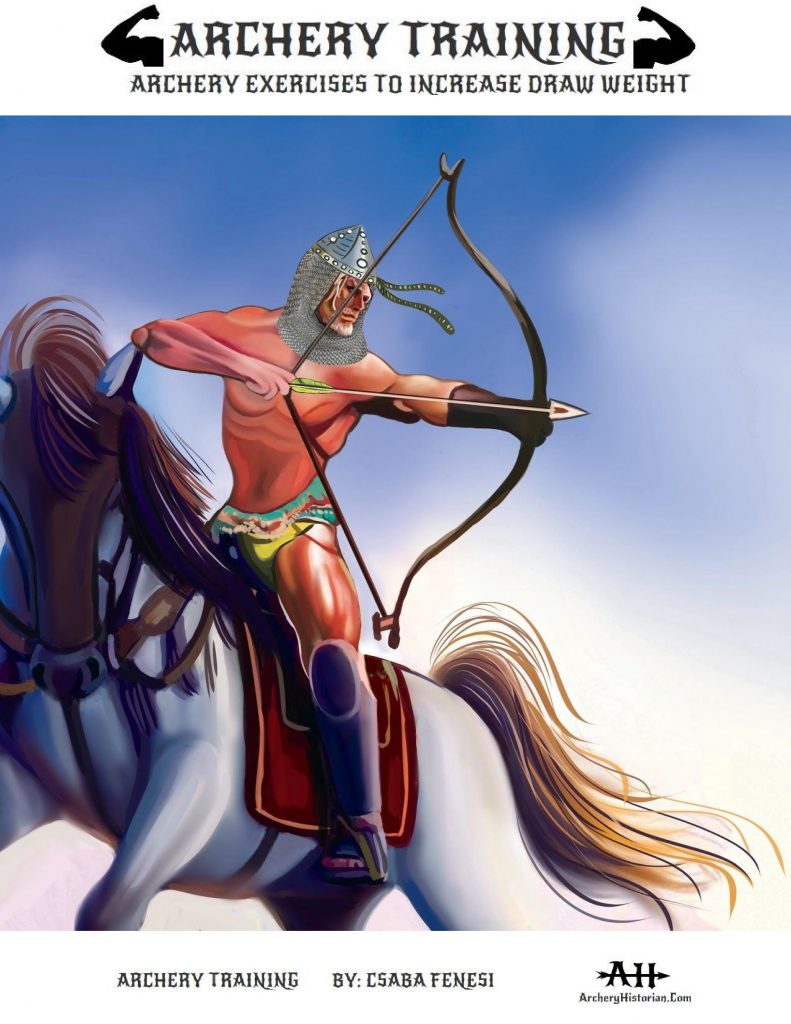Archery Exercises to Increase Draw Weight – Strengthen Archery Muscles
Why Do Archery Exercises?
Archery is a physical activity that requires some physical strength and endurance. Archers of the past were able to draw bows that had draw weights of around one hundred pounds (# 100) or more. While we are not required to be as reliant on our physical strength in modern times, being stronger will have benefits for modern archers. Various archery exercises can improve strength and endurance, which will improve the archer’s ability to draw a heavier bow.
Benefits of Shooting a Heavier Bow
The benefit of being able to shoot a bow with a heavier draw weight is the fact that a heavier bow can fire a similar arrow faster and farther with a straighter trajectory than a lighter bow. A heavier bow, compared to a similar light bow firing the same arrows, will also deliver those arrows to their target with greater kinetic energy, ideal in hunting and warfare.
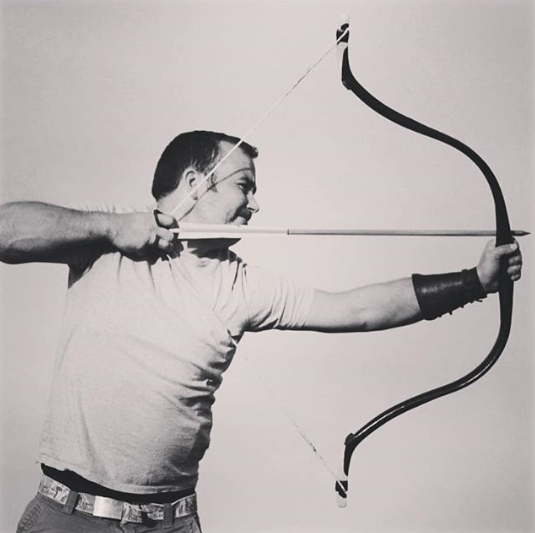
Building Bow Draw Strength – Basic Archery Exercises
The ability to shoot a heavy bow is acquired gradually. Be patient. Start with a light bow! Then, gradually increase the weight of the bow you are shooting with. Over time your muscles will adapt and strengthen, allowing you to shoot heavier bows. In the past, archers were initiated into the practice in childhood, allowing time to develop their skill and strength. Hunnic children would learn to ride a horse before they could walk and practiced archery at a very young age as well. A perfect example highlighting the gradual process of training to shoot heavier bows survives from the time of King Henry VII:
“[My yeoman father] taught me how to draw, how to lay my body in my bow … not to draw with strength of arms as divers other nations do … I had my bows bought me according to my age and strength, as I increased in them, so my bows were made bigger and bigger. For men shall never shoot well unless they be brought up to it.”
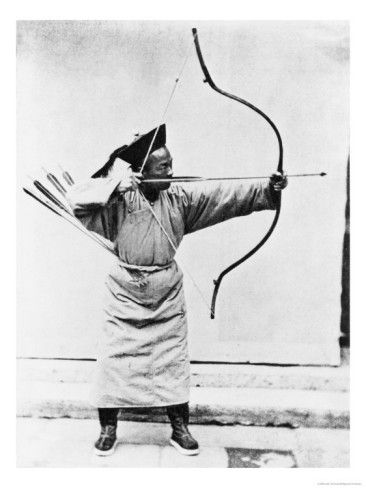
Basic Archery Exercise 1: The Overdraw
Make sure to use a bow that is slightly large for your particular draw length. This archery exercise is great as a warm-up before shooting. Simply draw your bow as you normally would, except go a few inches past the point at which you would normally hold your shot. Draw the bow in a slow, controlled movement and release back to the starting point in the same slow and deliberate movement. Repeat this movement as necessary. I usually perform approximately 20 repetitions as a warm-up. As a beginner, you should use a light bow and increase the weight of the bows used as you develop strength and endurance. This exercise can also be performed with resistance bands.
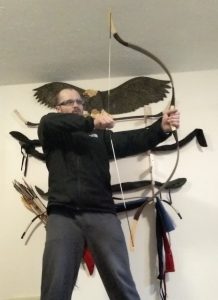

Basic Archery Exercise 2: Draw & Hold
This is another simple exercise that requires only the archer’s bow. Simply draw the bow and hold at full draw for approximately 3 to 5 seconds. Release to the starting position slowly and rest for 5 to 10 seconds. Repeat as necessary (10 to 20 times for the beginner).
Once you start gaining strength, increase the amount of time the bow is held at full draw and the number of repetitions. Make sure you increase the amount of rest in between repetitions. As a general guideline, you should rest for double the amount of time you held the bow at full draw. For example, if you were to hold the bow for 30 seconds, you should rest for one minute. It is recommended that you repeat these repetitions for approximately 30 minutes to an hour. There is potentially an infinite number of ways you could vary these simple yet effective archery exercises. This exercise can also be performed with resistance bands.
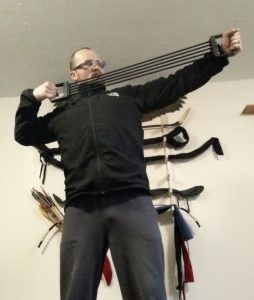
Basic Archery Exercise 3: Hand Gripper
Developing strong hands (forearm muscles) will assist the archer in drawing the bow with their draw hand and help with keeping the bow stable in the bow hand.
Lifting weights and any sort of resistance training that involves gripping bars will invariably strengthen your grip and forearm/hand muscles. Lifting weights and any sort of resistance training that involves gripping bars will invariably strengthen your grip and forearm/hand muscles. There are essentially two distinct kinds of grip which utilize the muscles in slightly different ways. The first kind of grip, known as the “crush” grip, is where you hold your hand around something, like when you are holding a dumbbell or barbell. The second grip is the pinch grip, where the tips of the thumb and other fingers are in contact with an object. I use a hand gripper tool to keep my grip strong, such as the one pictured below from amazon.com.
They vary in weight, so start small and work your way up. I do as many reps as possible in one day then try to beat my record the next day. I pick a weight where I can reach about 30-40 repetitions before reaching failure. Another variation you can do with hand grippers is to contract and hold the grip for several seconds.

Advanced Archery Exercises: A Workout Routine
In order to truly gain muscular strength and endurance, one must partake in a workout routine involving weight lifting. Before beginning a weight lifting routine it is recommended that one acquires at least a basic understanding of human anatomy and some of the muscles involved. What follows is a list of some of the major muscles involved in drawing a bow as well as some common exercises.
Hand & Forearm Muscles:
The muscles in the forearms help grip and pull the string to full draw in traditional archery. The only aids for drawing the bow will be thumb rings and gloves to protect the index, middle and ring fingers (Mediterranean or Western draw). Strong forearms are important for smooth shot execution when pulling the string and gripping the bow. The muscles of the forearm which flex the fingers are known as the flexors and the opposing muscles which extend the fingers are the extensors.
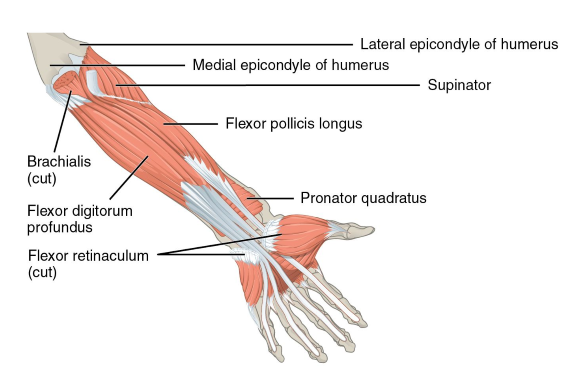
Back Muscles:
The back muscles are heavily engaged when an archer draws their bow. The muscles of the back include the trapezius, rhomboids and the latissimus dorsi. The trapezius and rhomboid muscles are responsible for pulling the shoulder blades together, which is a key movement when drawing a bow. Building strong back muscles will drastically increase the archer’s ability to shoot heavier bows.
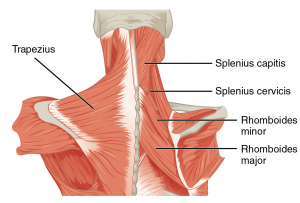
To get a more thorough understanding of the anatomy and muscles involved in archery the following books are recommended:
Archery Training Exercises:
The Basics:
Reps (Repititions):
A rep, short for repetition, describes a complete cycle of a movement in an exercise. In other words, it details the entire movement from the beginning or starting position, through to the top of the movement, then the lowering of the weight back to the starting position.
Sets:
A set is a group of repetitions. How many repetitions should you perform in a set? Good question. The answer varies depending on the result you wish to achieve. A typical rule of thumb for the number of reps to perform per set is to use a weight that is approximately 70 percent of your one-rep maximum. The maximum amount of weight you could lift for a specific exercise, with proper form, one time, is your one-rep maximum. By using roughly 70 percent of this weight you will be able to perform approximately 8 to 12 repetitions (slightly more for lower body exercises) before you reach failure. If you use a weight where you reach failure in less than 8 reps, you are training for strength and power; if you reach failure with a weight in more than 12 reps you are training for muscular endurance.
Warm-up and stretch:
Warming up and stretching are essential for avoiding injury. An injured archer cannot draw his or her bow properly and thus cannot effectively shoot arrows. A few minutes of warm-up activities before engaging in exercise will save possibly weeks or months of pain and rehabilitation. Warming up the muscles literally means bringing them up to an optimal temperature. A few minutes of light jogging or walking followed by some basic stretches is ideal. A detailed guide of individual stretches will not be given in this work, but it is highly recommended the archer take time to properly warm-up and stretch. There is a plethora of information available online which will enlighten the individual seeking a more thorough stretching routine.
1. Cable Rows
Balanced by a one-handed chest press, a controlled one-handed row is the main aspect of drawing a bow. Many variations of weighted rows exist. Experiment with as many as you can to find the ones you like best. A seated cable row is great for the beginner who desires to strengthen the lats and the rhomboids.
Performance:
Sit with your knees slightly bent at a cable row machine. Bend forward slightly, stretching the lats, to grasp the handles. Pull the handles toward your abdomen, pinching your shoulder blades together and stretching out your chest. Do not sway your body with your lower back. When the handle touches your body, you should be upright. Slowly return the handles to the starting position, stretching out the lats.
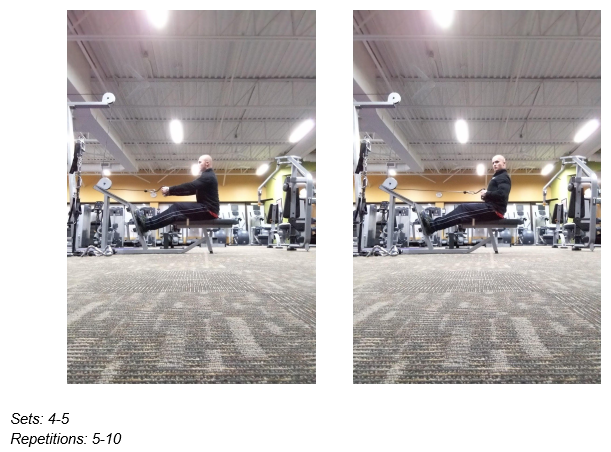 2. Dumbbell Rows
2. Dumbbell Rows
Free weight rows can be performed with either a barbell or dumbbells. These exercises are great for strengthening the back muscles. Performing dumbbell rows one side at a time allows for isolation of the lats and a greater range of motion,hence a higher quality contraction and stretch of the muscles involved. A one-handed dumbbell row closely simulates the motion involved in drawing a bow. The following describes a single-handed dumbbell row.
Performance:
With a dumbbell in your one hand, place the knee and shin on your opposite side on the end of a bench. Bend over from your waist until your upper body is almost parallel with the floor. Keep the foot on the same side of your body the dumbbell is on firmly on the floor. Put your free hand on the bench for support. Lift the weight as far as you can, concentrating on the back muscles instead of the arms. Hold at the top of the contraction, then lower the weight, stretching out the lats. Repeat as necessary.
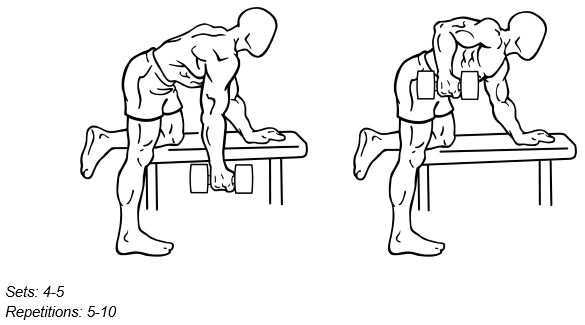
Click Image to download Archery Training by ArcheryHistorian.com for more exercises:



